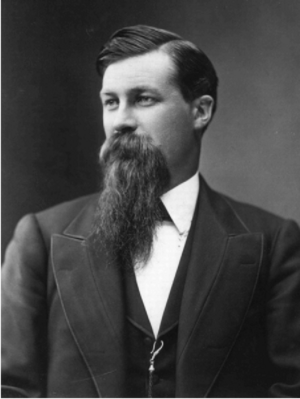Thomas Chrowder Chamberlin facts for kids
Quick facts for kids
Thomas Chrowder Chamberlin
|
|
|---|---|

Chamberlin in the 1870s
|
|
| Born | September 25, 1843 |
| Died | November 15, 1928 (aged 85) |
| Nationality | American |
| Alma mater | Beloit College (A.B., 1866) University of Michigan |
| Known for | Chamberlin–Moulton planetesimal hypothesis |
| Children | Rollin Thomas Chamberlin (1881–1948), geologist and skeptic of Wegener's continental drift hypothesis |
| Awards | Hayden Memorial Geological Award (1920) Penrose Gold Medal (1924) Penrose Medal (1927) |
| Scientific career | |
| Fields | Geology |
| Institutions | Columbian University University of Wisconsin University of Chicago |
| Doctoral advisor | Alexander Winchell |
| Signature | |
Thomas Chrowder Chamberlin (born September 25, 1843 – died November 15, 1928) was an American geologist and teacher. He studied the Earth's history and how it was formed. He also helped start the Journal of Geology in 1893, which is a very important science magazine.
Contents
Biography
Early Life and Education
Thomas Chamberlin was born on September 25, 1843, in Mattoon, Illinois. When he was three, his family moved to a farm near Beloit, Wisconsin. His father was a farmer and a Methodist minister.
Thomas went to a special school before attending Beloit College. There, he studied old languages like Greek and Latin. But he also became very interested in natural science. While at college, he led a church choir and enjoyed sports and debates.
After finishing college in 1866, Chamberlin taught high school for two years. He even became a principal. In 1867, he married Alma Wilson.
Geological Discoveries
In 1868, Chamberlin took advanced classes at the University of Michigan. He focused on geology to improve his science knowledge. From 1869 to 1873, he taught natural science at Whitewater Normal School.
In 1873, he joined the faculty at Beloit College. He taught geology, zoology, and botany. That same year, he started working on a big geological survey of Wisconsin. This survey helped him understand the land better.
He studied areas covered by thick glacial deposits. This led him to realize that Earth had experienced many ice ages. His ideas about these glacial stages in North America are still used today.
In 1875, he even started a business selling spring water with his brother.
In 1876, Chamberlin became the main geologist for the Wisconsin survey. He oversaw the final report, which was four volumes long. He wrote about glacial deposits, ancient bedrock, lead-zinc ores, and soils. This work made him famous across the country.
Because of his great work, he was made head of the glacial division of the U.S. Geological Survey in 1881. Later, he became president of the University of Wisconsin from 1887 to 1892.
Scientific Ideas
In 1890, Thomas Chamberlin wrote about "the method of multiple working hypotheses." He believed scientists should think about several possible ideas at once. They should then test each idea and get rid of those that don't fit the facts. This was different from just trying to prove one favorite idea. This method is still important in science today.
In 1892, Chamberlin helped create the geology department at the new University of Chicago. He taught there until 1918. He also led the Chicago Academy of Sciences from 1898 to 1914.
In 1905, Chamberlin and Forest Ray Moulton came up with a new idea about how our Solar System formed. It was called the Chamberlin-Moulton planetesimal hypothesis. They suggested that planets grew from smaller pieces called planetesimals. These small pieces slowly crashed together and built up the planets. This part of their idea is still thought to be true today.
Chamberlin also figured out that Earth was much older than people thought at the time. He even guessed that the Sun's energy came from inside atoms. This was a very smart guess for his time.
Awards and Legacy
Chamberlin received important awards for his work. He won the first Penrose Gold Medal in 1924. He also won the first Penrose Medal in 1927. He was also the president of the Geological Society of America in 1894.
Thomas Chamberlin continued to work until he passed away in Chicago on November 15, 1928.
His writings and papers are kept at the University of Chicago and Beloit College. His son, Rollin T. Chamberlin, was also a geologist. He later led the geology department at the University of Chicago.
There are buildings named after Thomas Chamberlin at Beloit College and the University of Wisconsin–Madison. A house at the University of Chicago is also named for him. Even a crater on the Moon and a crater on Mars are named in his honor. Mount Chamberlin in California also carries his name.
Works
Here are some of the books and papers Thomas Chamberlin wrote:
- Outline of a Course of Oral Instruction (1872)
- Geology of Wisconsin (1877)
- Preliminary paper on the terminal moraine of the second glacial epoch (U.S. Geological Survey, 1882)
- The rock scorings of the great ice invasions (U.S. Geological Survey, 1886)
- Chamberlin, T. C. (1890). "The method of multiple working hypotheses". Science 15 (366): 92–96. doi:10.1126/science.ns-15.366.92. PMID 17782687. (Reprinted in 1965: Chamberlin, T. C. (May 1965). "The method of multiple working hypotheses: With this method the dangers of parental affection for a favorite theory can be circumvented". Science 148 (3671): 754–759. doi:10.1126/science.148.3671.754. PMID 17748786. https://semanticscholar.org/paper/3d22814c199f0f956734d59dfd066d43e64f3a8d.)
- Contribution to the Theory of Glacial Motion (1904)
- With R. D. Salisbury, Geology (three volumes, 1907–09)
- The Origin of the Earth (1916)
- "Biographical Memoir of Thomas Chrowder Chamberlin: 1843-1928". In Biographical Memoirs, vol. 15. Washington: National Academy of Sciences.
See also
 In Spanish: Thomas Chrowder Chamberlin para niños
In Spanish: Thomas Chrowder Chamberlin para niños
- History of climate change science
- Geological Features of Wisconsin
- Ice Age Trail
- Strong inference

